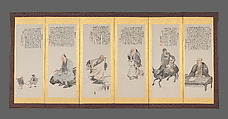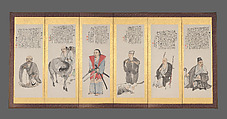Japanese Historical Figures
Tomioka Tessai Japanese
Not on view
Tomioka Tessai, one of the most popular literati painters of his day, was also deeply admired for his erudition, particularly his vast knowledge of Chinese and Japanese history. Produced in his mid-career, this pair of screens portrays twelve Edo-period notables—of various occupations and social strata—who inspired Tessai, with their biographies inscribed above.
Right-hand screen, from right:
Ogyū Sorai 荻生徂徠 (1666–1728), Confucian scholar and philologist
Botanka Shōhaku 牡丹花肖柏 (1443–1527), eccentric Zen monk-poet
Ike no Taiga 池大雅 (1723–1776), literati painter and calligrapher
Baisaō 売茶翁 (1675–1763), Ōbaku Zen monk and sencha practitioner
Hayashi Shihei 林子平 (1738–1793), scholar of maritime science and calligrapher
Ōishi Yoshio 大石良雄 (1659–1703) and Hachisuke 八助 (active ca. 1700), one of the Forty-Seven Ronin and his young assistant
Left-hand screen, from right:
Ishikawa Jōzan 石川丈山 (1583–1672), warrior-commander turned poet-calligrapher
Iwasa Matabei 岩佐又兵衛 (1578–1650), individualist painter
Matsuo Bashō 松尾芭蕉 (1644–1694), celebrated haiku poet
Miyamoto Musashi (Niten) 宮本武蔵 (二天) (ca. 1584–1645), samurai writer and painter
Takemaru Shōsuke 武丸正助 (1671–1757), farmer famous for his filial piety
Yoshida Mitsuyoshi (Suminokura Ryōi) 吉田光好(角倉了以) (1554–1614), wealthy merchant and engineer
This image cannot be enlarged, viewed at full screen, or downloaded.
This artwork is meant to be viewed from right to left. Scroll left to view more.









